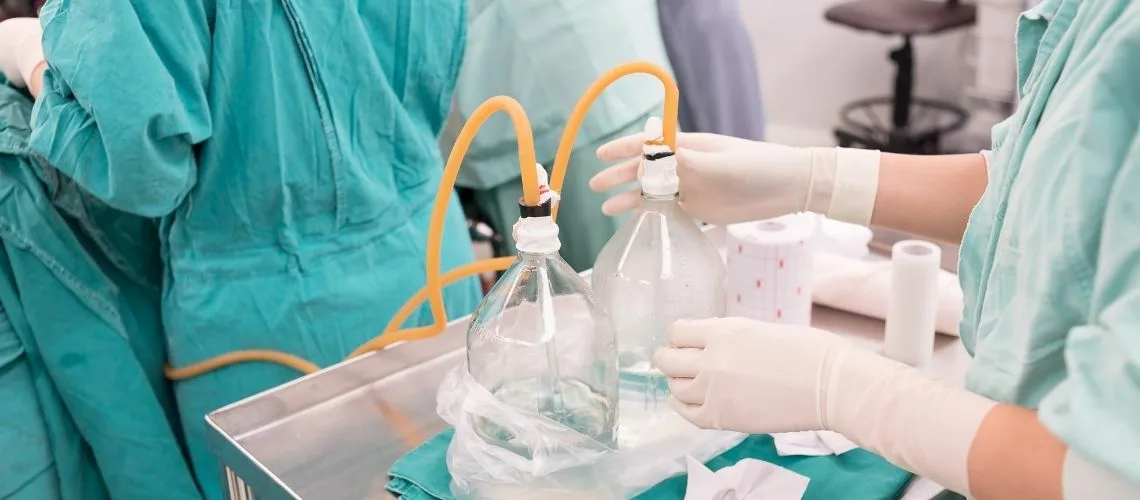Breast numbness may occur during or after breast aesthetics due to temporary nerve compression or stretching. In most cases, sensation gradually returns within weeks to months as healing progresses.
Causes of numbness in breast surgery are often related to incision placement and surgical technique. Procedures involving larger corrections may have a higher likelihood of temporary sensory changes.
Management of breast numbness includes observation, gentle massage, and nerve recovery support. Surgeons closely monitor healing, ensuring sensation typically improves without further intervention.
Permanent loss of breast sensation is rare but possible, especially in extensive procedures. Choosing an experienced surgeon and following postoperative care significantly reduces this risk.
Which Types of Breast Surgery Cause Numbness?
Many procedures performed within the scope of breast aesthetics or cancer surgery can lead to numbness. These surgeries can result in loss of sensation in the breast, armpit, and surrounding areas due to the cutting, stretching, or damage of nerves along with the surrounding tissues:
- Mastectomy
- Lumpectomy
- Breast augmentation
- Axillary lymph node dissection
- Surgical procedures following radiotherapy
During mastectomy and lumpectomy, the intercostobrachial nerve is frequently affected, causing numbness in the upper inner arm and armpit area. In breast augmentation, depending on the size and placement of the implant, the fourth, fifth, and sixth intercostal nerves may be damaged, leading to a decrease in sensation around the nipple and surrounding areas. Additionally, procedures like axillary lymph node dissection come with an increased risk of nerve damage.
In patients who undergo radiotherapy after surgery, nerve tissues may be more affected, which could result in permanent numbness. The extent of numbness also depends on factors such as the scope of the procedure, surgical techniques, the patient’s age, and any pre-existing health conditions.
How Does Nerve Damage Occur During Breast Surgery?
Nerve damage can occur during breast surgery due to the nature of the procedure and various related factors. Damage to the nerves can lead to sensory loss, numbness, or pain. The main situations where nerve damage can arise are as follows:
- Direct cutting
- Stretching and pulling
- Compression
- Thermal damage
- Scar formation
Procedures performed in the axillary region in particular increase the risk of nerve damage. The intercostobrachial nerve (ICBN) is frequently affected as it is responsible for the sensation of the upper inner arm. Additionally, the long thoracic nerve and thoracodorsal nerve may also be impacted during these types of operations.
The use of correct surgical techniques is crucial to prevent nerve damage. These include careful dissection, meticulous opening of the surgical area, and the use of appropriate instruments. Keeping the patient in the right position during surgery is also important in preventing nerve compression.
Is Post-Surgery Numbness Temporary or Permanent?
Numbness in the breasts after surgery is usually temporary, although it may become permanent in some cases. The duration and permanence of numbness depend on how much the nerves were affected, the type of surgery, and the patient’s overall health. Most patients regain sensation within a few days or weeks, but in some cases, this may take months or even years:
- Type of surgery
- Degree of nerve damage
- Patient’s health status
- Surgical technique
These factors play an influential role in determining how long numbness lasts and the course of recovery.
In cases of prolonged or permanent numbness, nerve repair and support of the healing process may be considered. During this time, physical therapy and certain medications (for example, gabapentin or amitriptyline) can be used. If numbness does not show significant improvement, more advanced surgical interventions may be carried out to repair nerve damage. The success of treatment generally relies on early intervention.
Which Areas Are Most Likely to Become Numb After Breast Surgery?
Numbness after breast surgeries commonly occurs due to the nerves being affected during the procedure. This numbness may present with varying severity and duration in different areas. Depending on the type of procedure, the following regions may be affected:
- Chest wall
- Armpit (axilla)
- Upper inner arm
- Nipple and areola
- Back and shoulder
Numbness, burning, or tingling sensations can occur in the chest wall due to the cutting or stretching of nerves. In patients who undergo axillary lymph node dissection, the armpit region and associated nerves may be affected, causing loss of sensation. Damage to the intercostobrachial nerve, in particular, can cause numbness in the upper inner arm. Numbness around the nipple and areola occurs when sensory nerves in this area are affected during surgery. In the back and shoulder, transferring tissue for reconstruction can trigger numbness in these areas.
The duration of numbness after surgery generally depends on the degree of nerve damage and the patient’s healing process. While some patients see improvement within a few months, for others it may become permanent. Although numbness can be troublesome for the patient, the body may adapt to it over time. With rehabilitation and treatments that support nerve regeneration, these symptoms can be reduced.
What Are the Risk Factors for Numbness After Breast Surgery?
Many factors play a role in the development of numbness after breast surgery. These factors may arise from patient-related conditions as well as surgery-specific causes. The risk of numbness can differ from person to person and is influenced by elements such as the scope of the procedure, technical aspects, and the patient’s overall health status.
Patient-Related Factors:
- Age
- Pre-surgery pain
- Psychological conditions
Surgery-Related Factors:
- Type of surgery
- Radiotherapy
- Number of lymph nodes removed
- Surgical technique
- Postoperative complications
Post-surgery numbness generally occurs due to direct or indirect effects on the nerves during the operation. The removal of lymph nodes, radiotherapy, or postoperative complications can prolong the duration and severity of this sensation. Additionally, younger women may be at higher risk depending on age-related factors, while psychological issues can adversely affect the recovery process.
Whether numbness is temporary or permanent depends on the severity of nerve damage and the patient’s healing process. The application of careful surgical techniques and diligent postoperative care can minimize sensory loss. Furthermore, taking into account factors like radiotherapy or lymph node removal in advance can help implement appropriate precautions.
Are There Preventive Measures to Reduce Numbness After Breast Surgery?
Various methods can be implemented to reduce potential numbness after breast surgery. Meticulous surgical planning, adopting nerve protection strategies, and using modern approaches contribute to lowering this risk:
- Careful surgical techniques aimed at preserving nerves
- Nerve grafting and reconnection methods
- Use of sensory-sparing mastectomy techniques
- Detailed preoperative planning
- Patient education and expectation management
Nerve-preserving surgical techniques are especially vital for minimizing sensory loss. Surgeons strive to protect the structure of nerves and employ advanced methods to minimize damage during surgery. Additionally, innovative approaches such as sensory-sparing mastectomy enable the preservation of nerves along with breast tissue.
Postoperative rehabilitation also plays a key role. Physical therapy, nerve-stimulating exercises, and other supportive treatments can accelerate the recovery process of damaged nerves.
References
- Kinne, D. W., & Silen, W. (1990). Breast sensory loss following aesthetic and reconstructive breast surgery. Plastic and Reconstructive Surgery, 85(4), 619-623.
- Pinchuk, V., et al. (2008). Nerve-sparing techniques in breast augmentation: A study on preserving sensation. Aesthetic Plastic Surgery, 32(2), 330-336.
- Rohrich, R. J., & Gosman, A. A. (2004). Sensory changes after breast surgery: Assessment and outcomes. Plastic and Reconstructive Surgery, 114(4), 1169-1175.
- Lossing, C., et al. (2016). Long-term sensation outcomes in patients undergoing breast augmentation and reduction procedures. Journal of Plastic, Reconstructive & Aesthetic Surgery, 69(1), 109-117.

Op. Dr. Erman Ak is an internationally experienced specialist known for facial, breast, and body contouring surgeries in the field of aesthetic surgery. With his natural result–oriented surgical philosophy, modern techniques, and artistic vision, he is among the leading names in aesthetic surgery in Türkiye. A graduate of Hacettepe University Faculty of Medicine, Dr. Ak completed his residency at the Istanbul University Çapa Faculty of Medicine, Department of Plastic, Reconstructive and Aesthetic Surgery.
During his training, he received advanced microsurgery education from Prof. Dr. Fu Chan Wei at the Taiwan Chang Gung Memorial Hospital and was awarded the European Aesthetic Plastic Surgery Qualification by the European Board of Plastic Surgery (EBOPRAS). He also conducted advanced studies on facial and breast aesthetics as an ISAPS fellow at the Villa Bella Clinic (Italy) with Prof. Dr. Giovanni and Chiara Botti.
Op. Dr. Erman Ak approaches aesthetic surgery as a personalized art, tailoring each patient’s treatment according to facial proportions, skin structure, and natural aesthetic harmony. His expertise includes deep-plane face and neck lift, lip lift, buccal fat removal (bichectomy), breast augmentation and lifting, abdominoplasty, liposuction, BBL, and mommy makeover. He currently provides safe, natural, and holistic aesthetic treatments using modern techniques in his private clinic in Istanbul.









